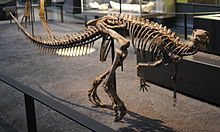Dryosauridae was a family of primitive iguanodonts, first proposed by Milner & Norman in 1984. They are known from Middle Jurassic to Early Cretaceous rocks of Africa, Europe, and North America.[1][2][3][4]
| Dryosauridae Temporal range: Middle Jurassic – Early Cretaceous,
| |
|---|---|

| |
| Dysalotosaurus skeletal mount in Berlin | |
| Scientific classification | |
| Domain: | Eukaryota |
| Kingdom: | Animalia |
| Phylum: | Chordata |
| Clade: | Dinosauria |
| Clade: | †Ornithischia |
| Clade: | †Ornithopoda |
| Clade: | †Iguanodontia |
| Clade: | †Dryomorpha |
| Superfamily: | †Dryosauroidea Milner & Norman, 1984 |
| Family: | †Dryosauridae Milner & Norman, 1984 |
| Subgroups | |
Classification edit
List of genera edit
- Callovosaurus, from the Middle Jurassic of the United Kingdom, is the oldest known dryosaurid.[3]
- Dryosaurus, from the Upper Jurassic of the United States, is the type genus of Dryosauridae.
- Dysalotosaurus
- Elrhazosaurus, from the Lower Cretaceous of Niger, was considered a nomen dubium by Poole in 2022[5]
- Eousdryosaurus, from the Upper Jurassic of Portugal, was originally described as a dryosaurid,[6] but some phylogenetic analyses have recovered it as an elasmarian.[7]
- Iyuku, from the Lower Cretaceous of South Africa, is only known from very young specimens,
- Kangnasaurus has been recovered by phylogenetic analysis as either a dryosaurid,[6] elasmarian,[7] or non-dryomorph iguanodont.[5]
- Hesperonyx, from the Upper Jurassic of Portugal, is a dryomorph of uncertain placement that may be either a dryosaurid or closer to ankylopollexians.[8]
- Valdosaurus, from the Lower Cretaceous of the United Kingdom, has been variously recovered as a dryosaurid[6][7] or a non-dryomorph iguanodont.[5]
Phylogeny edit
Until recently, many dryosaurids have been regarded as dubious (Callovosaurus and Kangnasaurus) or as species of the type member, Dryosaurus (Dysalotosaurus, Elrhazosaurus and Valdosaurus). However, more recent studies redescribe these genera as valid.[3][4][9][10][11] The cladogram below follows Paul M. Barrett, Richard J. Butler, Richard J. Twitchett and Stephen Hutt (2011).[11]
References edit
- ^ Norman, David B.; Weishampel, David B. (1990). "Iguanodontidae and related ornithopods". In Weishampel, David B.; Dodson, Peter; Osmólska Halszka (eds.). The Dinosauria. Berkeley: University of California Press. pp. 510–533. ISBN 0-520-06727-4.
- ^ Norman, David B. (2004). "Basal Iguanodontia". In Weishampel, D.B.; Dodson, P.; Osmólska H. (eds.). The Dinosauria (2nd ed.). Berkeley: University of California Press. pp. 413–437. ISBN 0-520-24209-2.
- ^ a b c Ruiz-Omeñaca, José Ignacio; Pereda Suberbiola Xabier; Galton, Peter M. (2007). "Callovosaurus leedsi, the earliest dryosaurid dinosaur (Ornithischia: Euornithopoda) from the Middle Jurassic of England". In Carpenter Kenneth (ed.). Horns and Beaks: Ceratopsian and Ornithopod Dinosaurs. Bloomington and Indianapolis: Indiana University Press. pp. 3–16. ISBN 978-0-253-34817-3.
- ^ a b Galton, Peter M. (2009). "Notes on Neocomian (Lower Cretaceous) ornithopod dinosaurs from England – Hypsilophodon, Valdosaurus, "Camptosaurus", "Iguanodon" – and referred specimens from Romania and elsewhere" (PDF). Revue de Paléobiologie. 28 (1): 211–273.
- ^ a b c Poole, Karen (2022). "Phylogeny of iguanodontian dinosaurs and the evolution of quadrupedality". Palaeontologia Electronica. doi:10.26879/702.
- ^ a b c Escaso, Fernando; Ortega, Francisco; Dantas, Pedro; Malafaia, Elisabete; Silva, Bruno; Gasulla, José M.; Mocho, Pedro; Narváez, Iván; Sanz, JosÉ L. (2014-07-29). "A new dryosaurid ornithopod (Dinosauria, Ornithischia) from the Late Jurassic of Portugal". Journal of Vertebrate Paleontology. 34 (5): 1102–1112. doi:10.1080/02724634.2014.849715. eISSN 1937-2809. ISSN 0272-4634.
- ^ a b c Dieudonné, P. -E.; Cruzado-Caballero, P.; Godefroit, P.; Tortosa, T. (2020-07-20). "A new phylogeny of cerapodan dinosaurs". Historical Biology. doi:10.1080/08912963.2020.1793979. eISSN 1029-2381. ISSN 0891-2963.
- ^ Rotatori, Filippo Maria; Ferrari, Lucrezia; Sequero, Cristina; Camilo, Bruno; Mateus, Octávio; Moreno-Azanza, Miguel (2024-03-18). "An unexpected early-diverging iguanodontian dinosaur (Ornithischia, Ornithopoda) from the Upper Jurassic of Portugal". Journal of Vertebrate Paleontology. doi:10.1080/02724634.2024.2310066. eISSN 1937-2809. ISSN 0272-4634.
- ^ McDonald, A.T.; Kirkland, J.I.; DeBlieux, D.D.; Madsen, S.K.; Cavin, J.; Milner, A.R.C.; Panzarin, L. (2010). "New Basal Iguanodonts from the Cedar Mountain Formation of Utah and the Evolution of Thumb-Spiked Dinosaurs". PLOS ONE. 5 (11): e14075. doi:10.1371/journal.pone.0014075. PMC 2989904. PMID 21124919.
- ^ Andrew T. McDonald (2011). "The taxonomy of species assigned to Camptosaurus (Dinosauria: Ornithopoda)" (PDF). Zootaxa. 2783: 52–68. doi:10.11646/zootaxa.2783.1.4.
- ^ a b Paul M. Barrett; Richard J. Butler; Richard J. Twitchett; Stephen Hutt (2011). "New material of Valdosaurus canaliculatus (Ornithischia: Ornithopoda) from the Lower Cretaceous of southern England". Special Papers in Palaeontology. 86: 131–163.